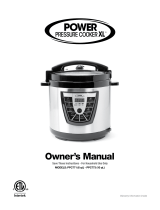
3534
EN
•Raw milk (farm milk): this must be boiled. It is also recom-
mended to let it boil for a long time. It would be unsafe to use
this milk without boiling it. You must then leave it to cool before
using it in your appliance. Culturing using yogurt prepared with
raw milk is not recommended.
•Dried skimmed milk powder: using powdered milk will result
in very creamy yogurt. Reconstitute the powder as directed on
the packet. Choose a whole milk, preferably long-life UHT. Raw
(fresh) or pasteurized fresh milk must be boiled then cooled and
needs the skin removing.
THE FERMENT FOR YOGURT
This is made either from:
• One shop-bought natural yogurt with the longest expiry date
possible; your yogurt will therefore contain more active ferment
for a firmer yogurt.
• From a freeze-dried ferment. In this case, follow the activation time
specified on the ferment instructions. You can find these ferments in
supermarkets, pharmacies and in certain health product stores.
• From one of your recently prepared yogurt – this must be na-
tural and recently prepared. This is called culturing. After five
culturing processes, the used yogurt loses active ferments and
therefore risks giving a less firm consistency. You then need to
start again using a shop bought yogurt or freeze-dried ferment.
If you have boiled the milk, wait until it has reached room tem-
perature before adding the ferment.
TIPS FOR MAKING YOGURT
• You can make a large batch of natural yogurt directly in the bowl
(maximum quantity of 1 liter of milk). Wash the bowl in warm wa-
ter and washing up liquid, then rinse and dry them thoroughly.
• All the equipment used in the yogurt making process should
be sterilized using Milton sterilizing solution or cleaned in a di-
shwasher. Sterilizing is important to prevent the introduction of
undesirable airborne organisms which could interfere with the
incubation of the culture, and results in runny yogurt which will
not set.
• Prepare the yogurt mixture as instructed in the recipe book sup-
plied with your appliance. Also see the section “Choice of milk”.
• You can sweeten natural yogurt either when you eat them or
when you make them. After the yogurt is cooked, simply add su-
gar or honey. Alternatively, when preparing the yogurt mixture
dissolve the sugar after boiling the milk or dissolve in the cold
UHT milk. Use no more than 80g sugar for 1 liter milk.
• The “Yogurt Function” has a default cooking time of 8 hours.
The cooking time is adjustable from a minimum of 0.5 hour to a
maximum of 12 hours. A longer cooking time of 12 hours gives a
more acidic and firmer yogurt. A shorter cooking time of 6 hours
gives a sweeter, more fluid yogurt.
• When the yogurt cooking process has finished, the yogurt
should be cooled completely, covered with a lid or cling film. Chill
the yogurt in the refrigerator for at least 4 hours, preferably over-
night, before serving. This helps the yogurt to thicken slightly.
• Natural yogurts will keep for a maximum of 7 days in the re-
frigerator, depending on the freshness of the milk. Yogurts with
jam or additional ingredients added will keep for up to 3 days.
• Homemade yogurts do not contain the thickeners and stabi-
lizers contained in commercially produced yogurt and are often
thinner in consistency. Sometimes homemade yogurt has nutri-
tious clear whey on top which can be stirred back in. Alterna-
tively, you can pour it off.






















